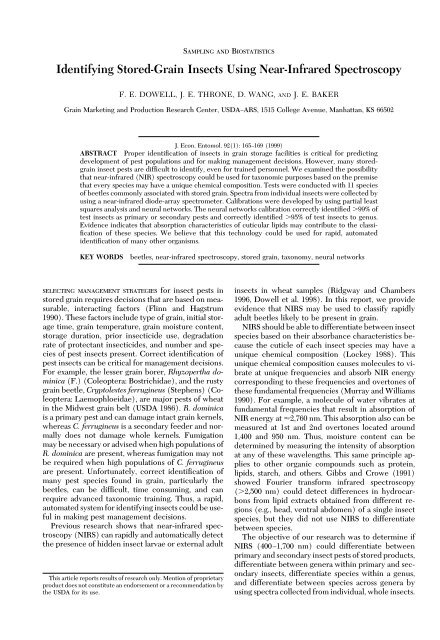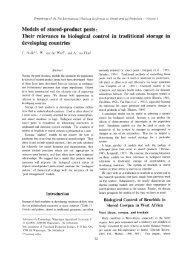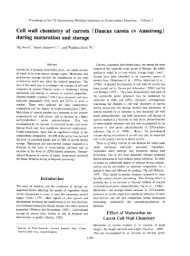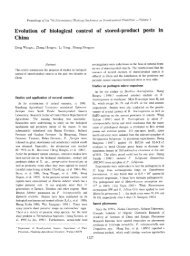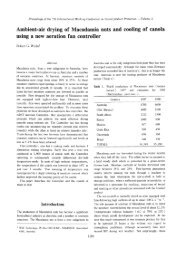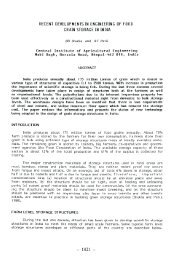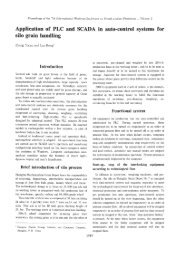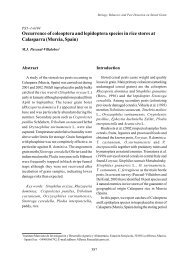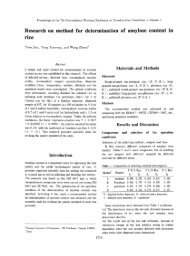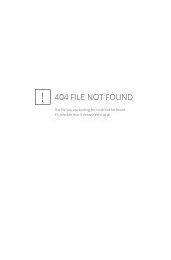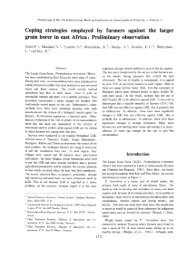Identifying Stored-Grain Insects Using Near-Infrared Spectroscopy
Identifying Stored-Grain Insects Using Near-Infrared Spectroscopy
Identifying Stored-Grain Insects Using Near-Infrared Spectroscopy
You also want an ePaper? Increase the reach of your titles
YUMPU automatically turns print PDFs into web optimized ePapers that Google loves.
SAMPLING AND BIOSTATISTICS<br />
<strong>Identifying</strong> <strong>Stored</strong>-<strong>Grain</strong> <strong>Insects</strong> <strong>Using</strong> <strong>Near</strong>-<strong>Infrared</strong> <strong>Spectroscopy</strong><br />
F. E. DOWELL, J. E. THRONE, D. WANG, AND J. E. BAKER<br />
<strong>Grain</strong> Marketing and Production Research Center, USDAÐARS, 1515 College Avenue, Manhattan, KS 66502<br />
J. Econ. Entomol. 92(1): 165Ð169 (1999)<br />
ABSTRACT Proper identiÞcation of insects in grain storage facilities is critical for predicting<br />
development of pest populations and for making management decisions. However, many storedgrain<br />
insect pests are difÞcult to identify, even for trained personnel. We examined the possibility<br />
that near-infrared (NIR) spectroscopy could be used for taxonomic purposes based on the premise<br />
that every species may have a unique chemical composition. Tests were conducted with 11 species<br />
of beetles commonly associated with stored grain. Spectra from individual insects were collected by<br />
using a near-infrared diode-array spectrometer. Calibrations were developed by using partial least<br />
squares analysis and neural networks. The neural networks calibration correctly identiÞed 99% of<br />
test insects as primary or secondary pests and correctly identiÞed 95% of test insects to genus.<br />
Evidence indicates that absorption characteristics of cuticular lipids may contribute to the classi-<br />
Þcation of these species. We believe that this technology could be used for rapid, automated<br />
identiÞcation of many other organisms.<br />
KEY WORDS beetles, near-infrared spectroscopy, stored grain, taxonomy, neural networks<br />
SELECTING MANAGEMENT STRATEGIES for insect pests in<br />
stored grain requires decisions that are based on measurable,<br />
interacting factors (Flinn and Hagstrum<br />
1990). These factors include type of grain, initial storage<br />
time, grain temperature, grain moisture content,<br />
storage duration, prior insecticide use, degradation<br />
rate of protectant insecticides, and number and species<br />
of pest insects present. Correct identiÞcation of<br />
pest insects can be critical for management decisions.<br />
For example, the lesser grain borer, Rhyzopertha dominica<br />
(F.) (Coleoptera: Bostrichidae), and the rusty<br />
grain beetle, Cryptolestes ferrugineus (Stephens) (Coleoptera:<br />
Laemophloeidae), are major pests of wheat<br />
in the Midwest grain belt (USDA 1986). R. dominica<br />
is a primary pest and can damage intact grain kernels,<br />
whereas C. ferrugineus is a secondary feeder and normally<br />
does not damage whole kernels. Fumigation<br />
may be necessary or advised when high populations of<br />
R. dominica are present, whereas fumigation may not<br />
be required when high populations of C. ferrugineus<br />
are present. Unfortunately, correct identiÞcation of<br />
many pest species found in grain, particularly the<br />
beetles, can be difÞcult, time consuming, and can<br />
require advanced taxonomic training. Thus, a rapid,<br />
automated system for identifying insects could be useful<br />
in making pest management decisions.<br />
Previous research shows that near-infrared spectroscopy<br />
(NIRS) can rapidly and automatically detect<br />
the presence of hidden insect larvae or external adult<br />
This article reports results of research only. Mention of proprietary<br />
product does not constitute an endorsement or a recommendation by<br />
the USDA for its use.<br />
insects in wheat samples (Ridgway and Chambers<br />
1996, Dowell et al. 1998). In this report, we provide<br />
evidence that NIRS may be used to classify rapidly<br />
adult beetles likely to be present in grain.<br />
NIRS should be able to differentiate between insect<br />
species based on their absorbance characteristics because<br />
the cuticle of each insect species may have a<br />
unique chemical composition (Lockey 1988). This<br />
unique chemical composition causes molecules to vibrate<br />
at unique frequencies and absorb NIR energy<br />
corresponding to these frequencies and overtones of<br />
these fundamental frequencies (Murray and Williams<br />
1990). For example, a molecule of water vibrates at<br />
fundamental frequencies that result in absorption of<br />
NIR energy at 2,760 nm. This absorption also can be<br />
measured at 1st and 2nd overtones located around<br />
1,400 and 950 nm. Thus, moisture content can be<br />
determined by measuring the intensity of absorption<br />
at any of these wavelengths. This same principle applies<br />
to other organic compounds such as protein,<br />
lipids, starch, and others. Gibbs and Crowe (1991)<br />
showed Fourier transform infrared spectroscopy<br />
(2,500 nm) could detect differences in hydrocarbons<br />
from lipid extracts obtained from different regions<br />
(e.g., head, ventral abdomen) of a single insect<br />
species, but they did not use NIRS to differentiate<br />
between species.<br />
The objective of our research was to determine if<br />
NIRS (400Ð1,700 nm) could differentiate between<br />
primary and secondary insect pests of stored products,<br />
differentiate between genera within primary and secondary<br />
insects, differentiate species within a genus,<br />
and differentiate between species across genera by<br />
using spectra collected from individual, whole insects.
166 JOURNAL OF ECONOMIC ENTOMOLOGY Vol. 92, no. 1<br />
Table 1. <strong>Stored</strong>-grain beetles (Coleoptera) used in the neural network and partial least squares analysis of NIR spectra when comparing<br />
species, genera, and primary versus secondary pests<br />
Code Common name ScientiÞc name Family<br />
FGB Flat grain beetle<br />
Secondary Pests<br />
Cryptolestes pusillus (Schönherr) Laemophloeidae<br />
RGB Rusty grain beetle Cryptolestes ferrugineus (Stephens) Laemophloeidae<br />
SGB Sawtoothed grain beetle Oryzaephilus surinamensis (L.) Silvanidae<br />
MGB Merchant grain beetle Oryzaephilus mercator (Fauvel) Silvanidae<br />
CFB Confused ßour beetle Tribolium confusum Jacquelin du Val Tenebrionidae<br />
RFB Red ßour beetle Tribolium castaneum (Herbst)<br />
Primary Pests<br />
Tenebrionidae<br />
LGB Lesser grain borer Rhyzopertha dominica (F.) Bostrichidae<br />
GB Larger grain borer Prostephanus truncatus (Horn) Bostrichidae<br />
GW Granary weevil Sitophilus granarius (L.) Curculionidae<br />
RW Rice weevil Sitophilus oryzae (L.) Curculionidae<br />
MW Maize weevil Sitophilus zeamais Motschulsky Curculionidae<br />
Materials and Methods<br />
About 20 adult insects were selected from each of<br />
11 beetle species commonly found in stored grain<br />
(Table 1). These species were obtained from stock<br />
colonies reared at 25 o C and 50Ð60% RH. Composition<br />
of laboratory diets for the different species were as<br />
follows: diets for the ßat grain beetle, Cryptolestes<br />
pusillus (Schönherr) (Coleoptera: Laemophloeidae);<br />
rusty grain beetle; sawtoothed grain beetle, Oryzaephilus<br />
surinamensis (L.) (Coleoptera: Silvanidae); and<br />
merchant grain beetle, Oryzaephilus mercator (Fauvel)<br />
(Coleoptera: Silvanidae), consisted of oatmeal:<br />
whole wheat ßour:BrewerÕs yeast:wheat germ (60:30:<br />
5:5), (vol:vol); diets for the confused ßour beetle,<br />
Tribolium confusum Jacquelin du Val (Coleoptera:<br />
Tenebrionidae), and the red ßour beetle, Tribolium<br />
castaneum (Herbst) (Coleoptera: Tenebrionidae),<br />
consisted of whole wheat ßour and BrewerÕs yeast<br />
(95:5), (vol:vol); the lesser grain borer was reared on<br />
whole wheat lightly dusted with wheat ßour; the<br />
larger grain borer, Prostephanus truncatus (Horn)<br />
(Coleoptera: Bostrichidae), and the maize weevil,<br />
Sitophilus zeamais Motschulsky (Coleoptera: Curculionidae),<br />
were reared on whole-kernel corn; and the<br />
rice weevil, Sitophilus oryzae (L.) (Coleoptera: Curculionidae),<br />
and granary weevil, Sitophilus granarius<br />
(L.) (Coleoptera: Curculionidae), were reared on<br />
hard red winter wheat.<br />
The live insects were individually placed in a black<br />
V-shaped trough (12 mm long, 10 mm wide, 5 mm<br />
deep) and illuminated with white light via a Þber<br />
bundle (8 mm diameter) positioned 13 mm from the<br />
top of the trough and oriented 45 o from vertical. A<br />
reßectance probe (2-mm diameter) was oriented vertically<br />
9.5 mm from the top of the trough. The reßectance<br />
probe carried the reßected energy to a spectrometer<br />
(DA7000, Perten Instruments, SpringÞeld,<br />
IL). The diode-array spectrometer measures visible<br />
(400Ð750 nm) and NIR (750Ð1,700 nm) reßectance at<br />
a rate of 30 spectra per second. Procedures included<br />
collecting a baseline, collecting 8 spectra from each of<br />
the insects, and averaging the 8 spectra for each insect.<br />
This resulted in spectra from 275 individual insects.<br />
Collecting and averaging the 8 spectra from each in-<br />
sect took 1 s. The baseline consisted of collecting a<br />
spectrum of the empty trough to use as a reference. A<br />
new baseline was collected after each group of 40<br />
insects.<br />
Data were analyzed using partial least squares regression<br />
(PLS) (Galactic Industries 1996) and a backpropagation<br />
neural network (NeuralWare 1995). Correlation<br />
plots (r 2 ) and factors indicating which<br />
wavelengths contribute to classiÞcations in 2-way<br />
comparisons were obtained using PLS (Murray and<br />
Williams 1990). Two-way comparisons were made using<br />
PLS by assigning a value of 1 or 2 to the comparisons<br />
of interest (for example, primary 1, secondary<br />
2).<br />
The neural network analysis gave classiÞcation percentages<br />
for all 2-way as well as higher-order comparisons<br />
(up to 11 species compared). The neural<br />
network had 1 hidden layer, 100 input nodes, and 2, 3,<br />
or 11 outputs. The 100-input nodes corresponded to<br />
the absorbance values at 10 nm increments from 700<br />
to 1,700 nm. The outputs corresponded to the comparisons<br />
being tested. The learning rate, momentum,<br />
and learning events used in the neural network were<br />
0.6, 0.4Ð0.5, and 10,000Ð30,000, respectively. The<br />
learning rate, momentum, learning events, and number<br />
of hidden layers affect the neural network accuracy<br />
and speed (Hecht-Neilsen 1989). For both the<br />
PLS and neural network analyses, even-numbered<br />
samples served as training or calibration sets, whereas<br />
odd samples were used for testing calibration models.<br />
Table 2 shows the comparisons tested. The classi-<br />
Þcation of paramount interest was primary versus secondary<br />
insects because management strategies for<br />
these 2 types of insects may be quite different and<br />
because knowing whether an insect is a primary or<br />
secondary pest is usually sufÞcient for making a management<br />
decision. In addition, insects were classed<br />
into their respective genera (2 or 3 comparisons)<br />
within the primary and secondary groupings, and<br />
classed into species within a genus (2 or 3 comparisons).<br />
A Þnal comparison sought to classify insects into<br />
their respective species independent of previous<br />
groupings (11 comparisons).
February 1999 DOWELL ET AL.: NIR IDENTIFICATION OF INSECT SPECIES 167<br />
Table 2. Accuracy of classifying insects species with calibrations developed by using partial least squares (PLS) regression and a neural<br />
network (NN)<br />
Comparisona n<br />
Primary vs Secondary <strong>Insects</strong><br />
NN<br />
% correct<br />
PLS<br />
no. PLS<br />
factors<br />
(FGB, RGB, SGB, MGB, RFB, CFB) vs<br />
(GW, RW, MW, LGB, GB)<br />
110 99.1 96.4 8<br />
Families or genera within primary or secondary<br />
(GW, RW, MW) vs (LGB, GB) 60 100 100 10<br />
(FGB, RGB, SGB, MGB) vs (RFB, CFB) 60 95 100 6<br />
(FGB, RGB) vs (SGB, MGB) vs (RFB, CFB) 60 96.7 Ñ Ñ<br />
GW vs RW vs MW<br />
Species within genera or family<br />
30 83.3 Ñ Ñ<br />
LGB vs GB 20 100 100 6<br />
FGB vs RGB 20 90 90 5<br />
SGB vs MGB 20 55 60 3<br />
RFB vs CFB 20 80 100 13<br />
GW vs RW 20 100 85 3<br />
GW vs MW 20 95 100 5<br />
RW vs MW 20 75 95 5<br />
All Species 110 71 Ñ Ñ<br />
a See Table 1 for species codes.<br />
We reasoned that the insect cuticle likely would<br />
absorb most of the NIR energy. To test this, the spectral<br />
absorbance of rice weevil cuticular lipids, extracted<br />
with a chloroform (CHCl 3) rinse and impregnated<br />
onto Þlter paper, was measured and analyzed for<br />
comparison with PLS correlations and factors. Lipids<br />
were extracted by placing 26.4 g of rice weevil adults<br />
in a 500-ml ßask, adding 200 ml CHCl 3, and gently<br />
swirling for 3 min at room temperature. The extract<br />
was Þltered through Whatman no. 1 Þlter paper, concentrated<br />
in a rotoevaporator, and an aliquot containing<br />
1 mg of lipid was applied to a Whatman no. 1 Þlter<br />
paper disk (6.4 mm diameter). The lipid concentration<br />
was 0.78 mg/cm 2 of Þlter paper.<br />
Spectra of ground samples of cuticle from 5 th -instar<br />
tobacco hornworm larvae, Manduca sexta (L.)(Lepidoptera:<br />
Sphingidae), and the (1Ð4)-linked hexasaccharide<br />
of 2-acetamido-2-deoxy-D-glucopyranoside<br />
derived from crab chitin (Sigma, St. Louis, MO)<br />
were obtained to determine if their absorbance peaks<br />
are identical or similar to the wavelengths found useful<br />
for detection.<br />
Table 3. Neural network results from an 11-way classification<br />
Actual<br />
species<br />
To test the robustness of NIR calibrations developed<br />
using the laboratory stock colonies, insects from<br />
each of 3 speciesÑthe foreign grain beetle, Ahasverus<br />
Advena (Waltl) (Coleoptera: Silvanidae); C. ferrugineus;<br />
and R. dominicaÑwere obtained from samples<br />
of wheat from bins in Kansas and classed using the NIR<br />
system. This testing occurred 6 mo after the original<br />
calibrations.<br />
Results and Discussion<br />
The neural network classiÞed 99.1% of primary and<br />
secondary insects correctly, whereas PLS had a lower<br />
classiÞcation percentage (96.4%) (Table 2). Both calibrations<br />
classiÞed insects by genus within primary<br />
and secondary groups with an accuracy of 95%. Classifying<br />
insect species within a genus resulted in correct<br />
classiÞcations ranging from 55 to 100%. In an 11-way<br />
classiÞcation among all species and using the neural<br />
network calibration, classiÞcation accuracies ranged<br />
from 30 to 100% (Table 3). The worst classiÞcations<br />
were the sawtoothed grain beetle versus merchant<br />
Predicted species a<br />
FGB RGB SGB MBG CFB RFB LGB GB GW RW MW<br />
FGB 90 10 Ñ Ñ Ñ Ñ Ñ Ñ Ñ Ñ Ñ<br />
RGB 40 50 10 Ñ Ñ Ñ Ñ Ñ Ñ Ñ Ñ<br />
SGB Ñ Ñ 30 30 Ñ Ñ 40 Ñ Ñ Ñ Ñ<br />
MGB Ñ Ñ 20 70 Ñ Ñ 10 Ñ Ñ Ñ Ñ<br />
CFB Ñ Ñ Ñ Ñ 60 40 Ñ Ñ Ñ Ñ Ñ<br />
RFB Ñ Ñ Ñ Ñ 20 80 Ñ Ñ Ñ Ñ Ñ<br />
LGB Ñ Ñ Ñ Ñ Ñ Ñ 100 Ñ Ñ Ñ Ñ<br />
GB Ñ Ñ Ñ Ñ Ñ Ñ Ñ 90 10 Ñ Ñ<br />
GW Ñ Ñ Ñ Ñ Ñ Ñ Ñ Ñ 100 Ñ Ñ<br />
RW Ñ Ñ Ñ Ñ Ñ Ñ Ñ Ñ 10 70 20<br />
MW Ñ Ñ Ñ Ñ Ñ Ñ Ñ Ñ Ñ 10 90<br />
See Table 1 for species codes.<br />
a Results are the percentage of actual species classiÞed into each of the 11 species categories.
168 JOURNAL OF ECONOMIC ENTOMOLOGY Vol. 92, no. 1<br />
Fig. 1. Correlation spectra for primary versus secondary<br />
stored-grain insects.<br />
grain beetle (55% correct) in the pair-wise comparison<br />
(Table 2) and the sawtoothed grain beetle versus<br />
all others (30% correct) in the 11-way classiÞcation<br />
(Table 3). Thus, the calibrations developed using neural<br />
network and broadest groupings (primary versus<br />
secondary) resulted in the highest classiÞcation accuracy.<br />
When examining the effect of wavelength regions<br />
on classiÞcation accuracies, the PLS results showed<br />
that data within the visible wavelength region did not<br />
improve classiÞcations or reduce the number of factors<br />
needed for calibrations (data not shown). Fewer<br />
factors are desirable because less information is<br />
needed to explain variability in the data. For example,<br />
for the primary versus secondary comparison, the calibration<br />
models developed using either the NIR or<br />
NIR plus visible wavelengths both resulted in 96.4% of<br />
insects correctly classed. The number of factors<br />
needed for the NIR and NIR plus visible region calibrations<br />
were 8 and 17 factors, respectively. Fewer<br />
factors when using only the NIR region likely occurred<br />
because there is little visible difference between<br />
many of the insect categories. Thus, including<br />
the visible region contributed no additional useful<br />
information.<br />
Further information about wavelengths contributing<br />
to classiÞcations can be derived from PLS correlation<br />
plots and factor weights. Correlation plots show<br />
that wavelengths of 450Ð700 nm, 900Ð1,400 nm, and<br />
1,500Ð1,700 nm were more highly correlated to insect<br />
species than other wavelengths (Fig. 1).<br />
The Þrst 2 factors of the PLS comparisons showed<br />
that wavelengths with the most weight occurred at<br />
1,130, 1,325, and 1,670 nm. The 3rd and 4th factors<br />
had peaks around 1,420 nm. Fig. 2 shows plots for 1 and<br />
3 PLS factors. When comparing the wavelengths from<br />
the Þrst 2 factors with absorbances of various functional<br />
groups, the absorbances correspond closely to<br />
the 1st and 2nd overtones of CH 3, and to a lesser extent<br />
CH 2 (Murray and Williams 1990). The CH combination<br />
overtones correspond with the 3rd and 4th fac-<br />
Fig. 2. PLS factor plots indicating wavelengths contributing<br />
to insect classiÞcations.<br />
tors. These absorbance regions also generally agree<br />
with those reported by Ridgway and Chambers<br />
(1996), but at overtones found at longer wavelengths<br />
(1,700 nm) when detecting the presence of insects in<br />
grain.<br />
CH 3 and CH 2 are common chemical moieties in<br />
components that make up the epicuticular lipids in<br />
insects. Insect cuticular lipids are composed mainly of<br />
fatty acids, alcohols, esters, glycerides, sterols, aldehydes,<br />
ketones, and hydrocarbons (Lockey 1988).<br />
Long-chain hydrocarbons often are major components<br />
of cuticular lipids in insects, but their concentration<br />
can vary widely, from 3 to nearly 95% of the<br />
total lipid. Hydrocarbons make up 32% of the total<br />
surface lipid in rice weevils (Baker et al. 1984). Fig. 3<br />
shows the difference spectra calculated by subtracting<br />
a spectra of rice weevil cuticular lipid on Þlter paper<br />
(0.78 mg/cm 2 ) from the spectra of Þlter paper treated<br />
with solvent only. This difference spectra with peaks<br />
Fig. 3. Spectra of cuticular lipids extracted from adult<br />
rice weevils.
February 1999 DOWELL ET AL.: NIR IDENTIFICATION OF INSECT SPECIES 169<br />
occurring at the CH 3 overtones (1,130 and 1,670 nm)<br />
supports the conclusions indicated by the PLS factors.<br />
Thus, each insect species appears to have molecules<br />
with unique vibrational characteristics that may be<br />
caused by the unique mixture of hydrocarbon molecules<br />
and other lipid classes.<br />
Spectra of the chitin hexamer and ground insect<br />
cuticle had absorbance peaks around 1,400Ð1,500 nm.<br />
Neither the correlation plots nor the factor weight<br />
plots indicated that this wavelength range was useful.<br />
Thus, it appears that the NIR system may have detected<br />
differences in cuticular lipids between species,<br />
but that the chitin within the cuticle did not contribute<br />
to classiÞcations. Other compounds contained in<br />
insect cuticle that could be contributing to classiÞcation<br />
include protein, catachols, pigments, and oxalates<br />
(Kramer et al. 1995).<br />
When classifying Þeld insects using calibrations developed<br />
from laboratory stock colonies, 100% of the C.<br />
ferrugineus were correctly classed as secondary insects<br />
and in the correct genus. The A. advena were not<br />
included in the original calibration; however, 80%<br />
were correctly classed by the model as secondary<br />
insects. For the R. dominica, 67% were correctly<br />
classed as primary insects. Of the R. dominica correctly<br />
classed as primary, 83% were placed in the correct<br />
genus. Of those placed in the correct genus, 100% were<br />
placed in the correct species. The calibration developed<br />
using laboratory colonies appears to classify Þeld<br />
insects with reasonable accuracy, especially considering<br />
that the conÞguration for illuminating and viewing<br />
insects had changed between the original calibration<br />
and subsequent testing of Þeld insects.<br />
<strong>Insects</strong> that enter traps can be counted electronically<br />
(Shuman and Weaver 1996). However, integration<br />
of Þltered NIR sensors within an insect trap could<br />
provide an automated means of not only counting the<br />
trapped insects but also identifying the insect to type<br />
or species. This type of timely information concerning<br />
pest insect populations in stored grain would certainly<br />
be an advantage when implementing control strategies.<br />
Computer vision, which uses digitized images from<br />
cameras and provides information about object color,<br />
shape, and size, could provide an alternate means of<br />
identifying insect species. Although computer vision<br />
could likely be integrated into an insect trap, it poses<br />
additional problems of proper lighting, shadows, insect<br />
presentation, image segmentation (Zayas and<br />
Flinn 1997).<br />
In summary, our results showed that NIR spectroscopy<br />
coupled with PLS or neural network spectral<br />
analysis techniques can be used to classify the 11 insect<br />
species examined in this study, with primary and secondary<br />
insects being classed with 99% accuracy. The<br />
unique composition of cuticular lipids in the different<br />
beetles may be partially responsible for the classiÞcations<br />
achieved with this system. Although we were<br />
not able to classify all tested insects to the species level<br />
with high accuracy, identiÞcation to species is not<br />
necessarily required for making pest management decisions<br />
in grain storages. IdentiÞcation to genus or<br />
identiÞcation as a primary or secondary pest is usually<br />
sufÞcient. In addition to stored grain insects, we believe<br />
that this technology could be used for rapid,<br />
automated identiÞcation of many other organisms.<br />
References Cited<br />
Baker, J. E., S. M. Woo, D. R. Nelson, and C. L. Fatland.<br />
1984. OleÞns as major components of epicuticular lipids<br />
of three Sitophilus weevils. Comp. Biochem. Physiol. B<br />
77: 877Ð884.<br />
Dowell, F. E., J. E. Throne, and J. E. Baker. 1998. Automated<br />
nondestructive detection of internal insect infestation of<br />
wheat kernels using near-infrared reßectance spectroscopy.<br />
J. Econ. Entomol. 91: 899Ð904.<br />
Flinn, P. W., and D. W. Hagstrum. 1990. <strong>Stored</strong> grain advisor:<br />
a knowledge-based system for management of insect<br />
pests of stored grain. AI Applications Nat. Res. Manage.<br />
4: 44Ð52.<br />
Galactic Industries. 1996. Grams/32 userÕs guide, version 4.0.<br />
Galactic, Salem, NH.<br />
Gibbs, A., and J. H. Crowe. 1991. Intra-individual variation in<br />
cuticular lipids studied using fourier transform infrared<br />
spectroscopy. J. Insect Physiol. 37: 743Ð748.<br />
Hecht-Neilsen, R. 1989. Neural computing. Addison-Wesley,<br />
New York.<br />
Kramer, K. J., T. L. Hopkins, and J. Shaefer. 1995. Applications<br />
of solids NMR to the analysis of insect sclerotized<br />
structures. Insect Biochem. Mol. Biol. 25: 1067Ð1080.<br />
Lockey, K. H. 1988. Lipids of the insect cuticle: origin, composition<br />
and function. Comp. Biochem. Physiol. B 89:<br />
595Ð645.<br />
Murray, I., and P. C. Williams. 1990. Chemical principles of<br />
near-infrared technology, pp. 17Ð34. In P. C. Williams<br />
and K. H. Norris [eds.], <strong>Near</strong>-infrared technology in the<br />
agricultural and food industries. American Association of<br />
Cereal Chemists. St. Paul, MN.<br />
NeuralWare. 1995. Reference guide. NeuralWare, Pittsburgh,<br />
PA.<br />
Ridgway, C., and J. Chambers. 1996. Detection of external<br />
and internal insect infestation in wheat by near-infrared<br />
reßectance spectroscopy. J. Sci. Food Agric. 71: 251Ð264.<br />
Shuman, D., and D. Weaver. 1996. Innovations in electronic<br />
monitoring of stored-grain insects, pp. 57Ð1 to 57Ð4. In<br />
Proceedings, Annual International Research Conference<br />
On Methyl Bromide Alternatives and Emissions Reductions,<br />
4Ð6 November 1996, Orlando, FL. Methyl Bromide<br />
Alternatives Outreach, Fresno, CA.<br />
U.S. Department of Agriculture. 1986. <strong>Stored</strong>-grain insects.<br />
U.S. Dep. Agric. Agric. Res. Serv. Agric. Handb. 500.<br />
Zayas, I. Y., and P. W. Flinn. 1997. Detection of insects in<br />
bulk wheat samples with machine vision, paper no.<br />
973149. Presented at the Annual American Society of<br />
Agricultural Engineers meeting, 10Ð14 August 1997, Minneapolis,<br />
MN, ASAE, St. Joseph, MI.<br />
Received for publication 3 February 1998; accepted 22 September<br />
1998.


